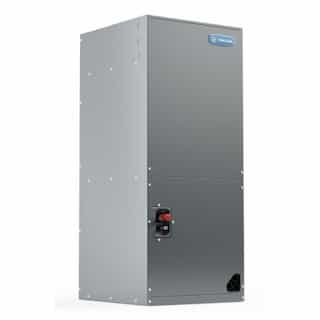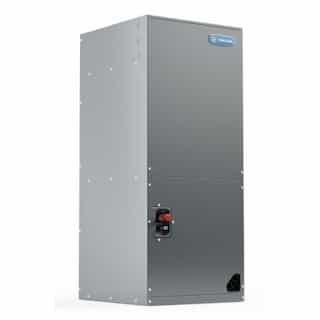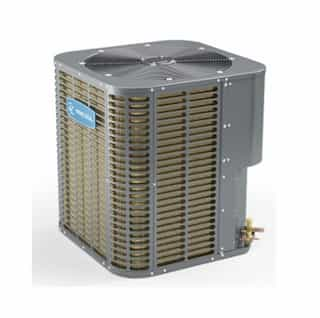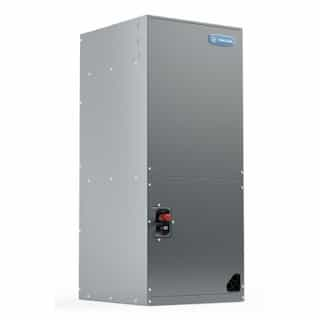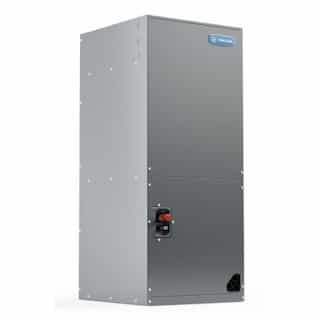What is an air handler?
An air handler, or air handling unit, distributes conditioned air and works as the indoor part of an HVAC split system. Air handlers typically require a corresponding outdoor unit, such as a heat pump or condensing unit, to provide heating and cooling. The air handler consists of internal components that work to distribute the conditioned air, usually including the:
- Blower motor
- Evaporator Coil
- Air Filter
What is an HVAC split system?
A heating, ventilation, and air conditioning (HVAC) split system refers to any home cooling system that is made up of at least two individual units: one located inside the home, and one located outdoors. The indoor unit has an evaporator that pulls heat from the indoor air and a blower that circulates cooled air throughout the room. The outdoor compressor unit receives refrigerant from the indoor unit via copper tubing, expels the heat outside, and sends cooled air indoors. In this sense, a split system is similar to central AC.
Unlike central air, however, split system air conditioners don’t have ductwork that delivers cooled air throughout the home through a set of vents. Instead, they have indoor air handling units installed in different areas of the home. Each indoor unit can be controlled separately, usually with a small remote control.
What is the difference between a central air conditioner and a heat pump system?
A central air conditioner can typically only cool a building, not heat it. It relies on another source, such as a furnace, to provide heat. Heat pumps, however, can provide both central heating and air conditioning.
In split system heat pump systems, the heat pump acts as the outdoor unit while the air handler acts as the indoor unit. A packaged heat pump system includes the heating and cooling components in the same unit.
What are the benefits of using a split system?
Often referred to as ductless mini-split systems, this AC system offers many benefits:
Cost savings
Installing a central air conditioning system in a home that doesn’t have existing ductwork can be a costly, time-consuming process. Because they’re ductless, split systems are easier and less expensive to install, requiring minimal space to run refrigerant lines to an outdoor AC unit. And their energy efficiency translates into lower utility bills, too. EPA reports that heat pumps are one of the thermostat, so you can set up multiple zones throughout your home to cool it more efficiently. For example, you may want to cool the second story for comfortable sleeping on a warm summer evening, but you don’t need cooling on the first floor. Zoned control saves money on energy costs because you aren’t cooling spaces that aren’t in use.
Flexibility
Homes with central air have air vents throughout, on the floor, walls, or both. These vents limit a homeowner’s interior design choices – for example, you don’t want to block a vent with furniture or a throw rug, as this will decrease your home’s energy efficiency. Split systems offer more flexibility. While wall-mounted mini-split units are common, you can also choose floor units or indoor air handlers that are mounted to the ceiling. Since they have a remote control, you can easily turn the indoor unit on and off, or adjust the temperature.
Should I choose a split system for my home?
Not sure if split system HVAC is the right choice for your cooling needs? A ductless mini split air conditioner is a good fit if:
- You want a customizable, multi-zone system instead of whole-home cooling.
- Your home does not have ductwork, or the existing ductwork requires costly repairs.
- You have ducted system central air but want a cooling system for a new addition, such as a sunroom or a converted garage.
A mini-split system can also be a good choice for commercial buildings, providing cost and energy savings, as well as temperature control in individual rooms or offices.
What are the SEER and HSPF ratings?
SEER stands for Seasonal Energy Efficiency Ratio. It measures the efficiency of an air conditioner or a heat pump when cooling. The higher the SEER rating, the more efficient the air conditioning system or heat pump. The standard rating for air conditioners is 13. HVAC units with a higher SEER rating cost more upfront but will save you money on your energy bills over time.
HSPF stands for Heating Seasonal Performance Factor. This efficiency rating measures the average efficiency of a heat pump when heating. The current mandated minimum HSPF rating for heat pumps is 8.8, up from the previous standard of 8.2. ENERGY Star-rated products will have good SEER and HSPF ratings.
Since heat pumps transfer air, the energy efficiency of a heat pump declines as the temperature outside drops. Because of this, heat pumps typically work best in warmer climates or areas with moderate temperatures.
Shop HVAC Equipment at HomElectrical
If you’re in the market for a split AC system air handler or heat pump, choose HomElectrical. Serving contractors, HVAC technicians, and DIY homeowners throughout the United States, HomElectrical carries an extensive selection of equipment and parts. In addition to split system HVAC, we offer thermostats, electric heaters, and even gas furnaces and fireplaces. With products from trusted suppliers and fast shipping, HomElectrical is a one-stop shop for your next project. Call us at 888.616.3532 with questions or create an account to shop online today.
